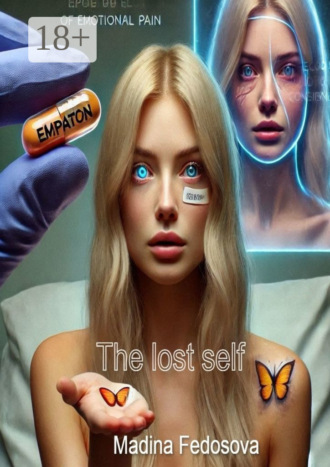
Полная версия
The lost self
The articles described him as a visionary, a brilliant scientist dedicated to alleviating human suffering, a pioneer on the frontiers of brain science. He was often quoted, speaking with passion and conviction about the transformative potential of his work, and was frequently featured in photographs. He was very handsome.
She also sought information about “Empathon,” the institute’s signature therapy, which was touted as a “revolutionary new approach” to treating trauma, depression, and a range of other emotional disorders. In promotional materials, it was described in glowing terms, emphasizing its personalized approach, cutting-edge technology, and astonishing success rates. “Empathon” was designed to make any patient’s life that used it more “harmonious.” One article said that it was even named after the word “empathy.”
However, Eleanor noticed that Empathon was very vaguely explained, stating that it was “advanced technology.” She felt that they never clearly gave a description of the technology itself. Eleanor was still doubtful, as she felt it was all too good to be true.
The program involved a combination of medication, therapy, and mindfulness practices, all designed to help participants manage their emotions and develop coping mechanisms. The website featured testimonials from individuals who claimed that the program had transformed their lives, putting them back on track after years of suffering.
Eleanor remained skeptical, yet deep down, she was drawn to the promise of relief. She was weary of the constant pain, the relentless nightmares, the suffocating loneliness. She longed to feel normal again, to reconnect with the world, to find even a semblance of peace.
After weeks of agonizing deliberation, haunted by both the promises and potential pitfalls of the Phoenix Institute, Eleanor finally made a decision. It was a cold, gray morning, the oppressive atmosphere mirroring the turmoil in her soul. Outside the cabin windows, the wind howled, rattling the panes and creating an unsettling symphony of sounds. She stood by the window, gazing at the bleak landscape, feeling utterly alone and desperate. She had to do it.
With trembling hands, she picked up the phone, feeling the cold plastic against her skin. Each digit she dialed felt like a step into the unknown, a commitment she couldn’t easily undo. She hesitated for a moment, her finger hovering above the final number, and doubts flooded her mind. Was she making the right choice? Was she chasing a false hope? But the thought of continuing to live in the suffocating grip of her grief was unbearable.
The phone rang, each ring echoing in her heart with a frantic beat. Finally, a pleasant voice answered on the other end. “Phoenix Institute, how may I help you?” The voice was warm and professional, carefully cultivated to convey competence and compassion.
“I’m calling about the Empathon program,” Eleanor said, her voice trembling slightly despite her best efforts. “I’m interested in learning more.” She paused, swallowing hard and trying to steady her nerves. This was it.
“Certainly,” the voice replied, still smooth and professional. “May I have your name and contact information, please?” Eleanor provided her details, reciting her name and address in a detached, almost mechanical voice. As she spoke, she felt a strange sense of dissociation, as if she were observing herself from the outside, a character in a play.
Hours later, Eleanor received a call from Dr. Charles Morrow, who identified himself as the lead researcher on the Empathon project. His voice was warm and soothing, and he spoke with a gentle empathy that put Eleanor at ease.
“I understand you’re interested in learning more about our program, Mrs. Vance,” Dr. Morrow said. “I’d be happy to answer any questions you may have.”
Eleanor hesitated, unsure where to begin. “I…I lost my husband six months ago,” she said, her voice catching with emotion. “I’m having a hard time coping.”
“I’m so sorry to hear that, Mrs. Vance,” Dr. Morrow said, his voice filled with empathy. “Grief can be a very challenging emotion. Our program is designed to help people like you, people who have experienced a significant trauma and are struggling to move forward.”
“How does it work?” Eleanor asked.
“Empathon is a revolutionary new drug that helps regulate the emotional centers of the brain,” Dr. Morrow explained. “It allows you to process your emotions in a safe and controlled environment, without experiencing intense pain.”
He continued, “We combine medication with individual therapy sessions, mindfulness exercises, and creative activities, offering a holistic approach to healing. We believe in nurturing the whole person, helping them rediscover their strengths and find joy in life again.” Eleanor listened intently, and her skepticism began to yield to a tentative hope. Dr. Morrow’s words were soothing, his tone persuasive.
“What are the risks?” Eleanor asked, her voice trembling.
“Like any medication, Empathon can cause side effects,” Dr. Morrow admitted. “Some patients experience mild headaches, nausea, or fatigue. However, these side effects are usually temporary and manageable. We closely monitor our participants to ensure their safety and well-being.”
“But what about the long-term effects?” Eleanor pressed, a note of anxiety creeping into her voice. This was her biggest concern: trading short-term relief for potential long-term problems. “I’ve read about experimental treatments that seemed promising at first but then had unintended consequences down the line.” She had done her research, trying to uncover any negative effects, but had failed to find any.
Dr. Morrow paused for a moment, and his voice became more measured. “That’s a very valid concern, Mrs. Vance, and one we take very seriously. Our studies indicate that the benefits of Empathon are long-lasting. However, Empathon is very new, and we cannot guarantee that it will not have any long-term effects.” He spoke a lot, but essentially he said nothing, and that concerned Eleanor.
“Our program participants have reported significant improvements in their mood, their relationships with loved ones, and their overall quality of life. What’s even better is that all of them reported a return of their previous feelings.” However, he didn’t mention that one of the participants was found dead after Empathon’s treatment failed.
He continued, “We conduct extensive follow-up studies to monitor the long-term well-being of our patients. We’ve also noticed that those who lead more quiet and solitary lives tend to benefit more, while those in more bustling environments do not.” Eleanor immediately felt a chill of fear, realizing she fell squarely into the former category. He didn’t even know what her life was like.
Eleanor was silent, considering everything Dr. Morrow had said. It all sounded too good to be true – a miracle cure for a broken heart. But what if it wasn’t? What if it really worked? “I need to think about it,” she said finally.
“Of course, Mrs. Vance,” Dr. Morrow replied. “Take your time. I understand this is a significant decision. But if you’re looking for a way to heal and find peace again, I believe the Empathon program can help.”
They exchanged pleasant goodbyes, but after the call, Eleanor realized she was already ready for the next step. The conversation with Morrow had changed something within her, and she already felt that it was a beacon in a future that she wasn’t expecting. She looked at her reflection in the window and, for the first time in six months, saw a glimmer of hope amidst the shadows.
2.2 The Embrace of Serenity
Days dragged into one another, each a torturous echo of the last, filled with restless nights haunted by fragmented memories, and empty, echoing days that stretched before her like an endless wasteland.
Eleanor felt like a ghost, a disembodied figure drifting through the ruins of her former life. Her movements were automatic, her actions devoid of purpose, as if she were merely mimicking life, not truly living it. She missed David holding her, the taste of his lips.
The police investigation into David’s disappearance had stalled, mired in bureaucratic procedures and dead ends. The official conclusion remained unchanged: death by accidental drowning, a tragic but ultimately unremarkable case. But the seed of doubt, planted by the cryptic entries in David’s journal, continued to sprout in the fertile soil of Eleanor’s mind. It grew, twisting and turning, poisoning her thoughts with suspicion and uncertainty. She couldn’t shake the feeling that her husband had been murdered, and that something else was in the works.
One crisp morning, as the biting wind howled through the bare trees surrounding her secluded cabin, a sleek black car, an incongruous sight in the rustic setting, pulled into the driveway. The car, smooth and modern, seemed out of place in the harsh Vermont landscape, a symbol of the outside world intruding upon Eleanor’s self-imposed isolation. A woman emerged from the vehicle, her movements fluid and graceful, her presence radiating confidence and poise. She had a warm, genuine smile.
She introduced herself as Dr. Evelyn Reid, a representative from “Serenity Labs,” and extended a hand in greeting. Her hand was cold and detached, and Eleanor felt a slight shiver of oddness. Dr. Reid’s voice, soft and soothing, seemed almost hypnotic.
She presented Eleanor with an invitation – a beautifully crafted document printed on thick, high-quality paper. It spoke of an exclusive opportunity to participate in a groundbreaking therapeutic program designed to alleviate grief and emotional trauma, promising a path to healing and renewal. The text was carefully worded, filled with encouraging phrases and vague promises.
The invitation seemed like a lifeline, a chance to escape the suffocating grip of grief, a beacon of hope in the darkness of despair. There was also a photo of Alistair Thorne, which Eleanor was very interested in. However, this charming invitation lacked key details that should have alerted her.
“Mrs. Vance, we understand you’re going through an incredibly difficult time,” Dr. Reid said, her voice soothing and empathetic. “At Serenity Labs, we’ve developed a revolutionary new therapy, Empathon, that helps people process trauma and find peace of mind. We believe it could be immensely beneficial for you.”
Eleanor hesitated. Serenity. The name still sent a shiver down her spine. But the lure of escaping her debilitating grief was too powerful to resist. She had nothing to lose.
“What exactly is Empathon?” she asked, her voice barely audible. “It’s a carefully curated compound that targets the neural pathways responsible for emotional processing,” Dr. Reid explained, her eyes gleaming with scientific enthusiasm. “It helps to gently reframe traumatic memories, allowing you to find closure and reclaim your life. It doesn’t erase the past, Mrs. Vance. It simply helps you make peace with it.”
After days of cautious inquiries, during which Dr. Reid shared details and reassurances, Eleanor reluctantly agreed to participate in the Empathon project. Despite Dr. Reid’s persuasive arguments, a nagging voice of doubt still lingered in the back of Eleanor’s mind. She couldn’t shake the feeling that something was amiss, that she was overlooking some crucial detail. However, the desire for relief, the yearning for a new beginning, ultimately outweighed her reservations. She thought of David, of how much his disappearance had affected her, and how much she wanted him back.
She was transported to Serenity Labs, a sprawling, modern facility nestled among the tranquil hills of upstate New York. The journey itself was unsettling: a long and isolated drive along winding back roads that further separated her from the familiar world. As she stepped inside the building, she was immediately struck by the sterile and clinical atmosphere. The pristine white walls, the gleaming metallic surfaces, the silent corridors all contributed to a sense of detachment, as if she had entered a world devoid of emotion. But amidst this sterile environment, there was also a strange sense of calmness, almost hypnotic in its effect, as if this place was a refuge from the storm raging inside her. The place seemed quiet, but Eleanor had a feeling that she was locked in.
The initial weeks at Serenity Labs unfolded in a carefully orchestrated sequence of consultations, neurological evaluations, and therapy sessions.
Eleanor felt like a lab rat, subjected to a battery of tests and examinations, each designed to probe the depths of her trauma. The sessions were both physically and emotionally draining, forcing her to confront the pain she had been desperately trying to suppress. She was given little contact to the outside world and not allowed to connect with Sarah.
She was introduced to the other participants in the Empathon project – a small, carefully selected group of individuals, each grappling with their own unique personal tragedy. There was a war veteran haunted by the horrors of combat, a woman consumed by unbearable grief over the loss of a child, and a man struggling to rebuild his life after surviving a violent crime. As they shared their stories, a fragile bond began to form between them – a silent understanding born of shared pain and a collective yearning for a better future. From their connection, Eleanor felt more comfortable at the facility, but she still had doubts about her decision.
The facility encouraged their interaction, providing them with communal spaces where they could gather and share their experiences. These conversations, initially cautious and reserved, gradually evolved into more open and honest exchanges. Eleanor found herself drawn to the others, finding comfort in their shared experiences and strength in their collective resilience. They began to rely on one another, offering support and understanding in a place that often felt isolated and sterile. However, they were all acting very strange, like any personality they once had was washed away. Did that mean that Serenity Labs had already started their work on them?
Конец ознакомительного фрагмента.
Текст предоставлен ООО «Литрес».
Прочитайте эту книгу целиком, купив полную легальную версию на Литрес.
Безопасно оплатить книгу можно банковской картой Visa, MasterCard, Maestro, со счета мобильного телефона, с платежного терминала, в салоне МТС или Связной, через PayPal, WebMoney, Яндекс.Деньги, QIWI Кошелек, бонусными картами или другим удобным Вам способом.











